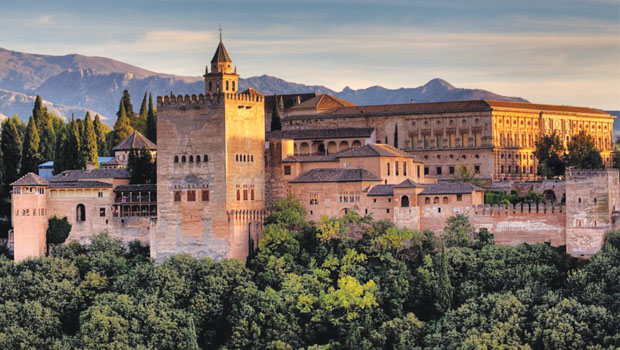In that it is washed by the waters of the Mediterranean Sea (on its eastern and southeastern flanks), the Bay of Biscay (to the north) and the Atlantic Ocean (along the west and south).
With more than 300 days of sunshine per year and a mild climate, average temperatures being in the order of 18C-30C (64F-86F), its sunlit beaches receive millions of tourists from all over the world each year.
The Mediterranean, the legendary “mare nostrum,” has sculpted a landscape of great character along the Costa Brava, where a steeply rising shoreline is indented with superbly scenic coves and lovely beaches.
Southwards, along stretches of coast eloquently dubbed Costa Dauroda (Golden), Costa Azahar (Orange Blossom), Costa de Valencia, Costa Blanca (White) or Costa Calida (Warm), it is a calm and peaceful sea that laps against beaches of golden sands, well served by a series of nearby cities and holiday resorts of renown.
In Andalusia, the Costa de Almeria, Costa Tropical and Costa del Sol are another three favorite destinations for tourists in search of sea and sun.
Marbella, the undisputed holiday capital of the Malaga coast, similarly receives a spectacular influx of visitors drawn by the local beaches, leisure and entertainment facilities, shops and boutiques, and the presence of world-famous personalities.
The Strait of Gibraltar, with the African coast visible through the haze on the opposite shore, links the Mediterranean to the Atlantic Ocean. Andalusia’s Atlantic coast is lent real personality by the presence of Cadiz and Huelva, with the so-called Costa de to Luz (Light) stretching along as far as Ayamonte on the Portuguese border.
Way up in Spain’s northeastern corner, it is this same Atlantic that batters the coast of Galicia, carving a spectacular landscape of deeply incised shores, small beaches and fjord-like inlets (rias), where the sea flows deep inland amidst scenery that is truly exquisite.
The entire Galician coast, with an altogether wetter, less torrid climate, is a much sought-after summer holiday spot. The Bay of Biscay, curling along the northern coast of Spain, has given rise to one of Spain’s most impressive and spectacular stretches of shoreline, the mountainous corniche. Elegant portside cities such as Gijon, Santander and Donostia-San Sebastian, their beaches set against natural backdrops of great beauty, the local architecture and an agreeable climate that paints the horizon a glistening green, serve to make the fringe of coast from the Basque Country through Cantabria and Asturias to Galicia, another of Spain’s busiest summer tourist havens.
Surrounded by the translucent waters of the Mediterranean, the Balearic Isles feature a series of characteristics which give the archipelago a personality all of its own. Cliffs and secluded coves, protected areas and beaches where the sun can be enjoyed to the full, lend shape and form to islands which, in turn, boast a wide range of supplementary leisure and entertainment facilities. Situated off the western coast of North Africa and over 1,000 km from the Iberian Peninsula, the Canary Islands are volcanic in origin.
The exceptional year-round climate and magnificent beaches make the islands an ideal spot to enjoy sea, sun and sand at any time or season of the year. The resort town of Puerto de la Cruz and the beaches in the south of Tenerife, the Playa del Ingles and Maspalomas Beaches on Gran Canaria, Puerto del Carmen on Lanzarote and Corralejo on Fuerteventura are just some of the places that receive the greatest influx of tourists.









